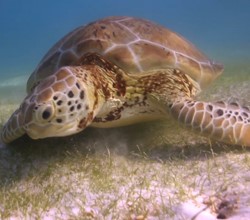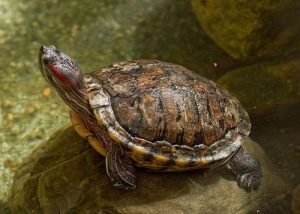New research is paying off long-term for endangered sea turtles facing illness and even death during Florida red tides. From 2011-2014, the NCCOS sponsored project “Brevetoxin Metabolism and Physiology – A Freshwater Model of Morbidity in Endangered Sea Turtles” used non-endangered freshwater turtles as models to determine the effects of Florida red tide on endangered sea turtles.

Sea turtles, such as this grazing green turtle, risk toxicity via algae toxin inhalation, ingestion, and exposure due to bioaccumulation and biomagnification. Credit: NOAA.
Karenia brevis, the Florida red tide organism, produces a suite of nerve toxins called brevetoxins. The toxins cause human respiratory illness along beaches and accumulate in shellfish, which, when consumed by humans, cause Neurotoxic Shellfish Poisoning. Severe blooms result in mass mortality of fish and a number of protected and endangered species. Among the species impacted are threatened and endangered sea turtles.
With sea turtles, brevetoxin concentrations that compromise organ physiological and immune functions are generally unknown. Due to the legal status of federally protected sea turtles, basic physiological questions cannot be addressed directly, as they require experimental investigation with controlled doses of toxins on healthy animals. The use of freshwater turtles as a surrogate physiological system allows for the determination of effects of brevetoxins on turtle physiology and immunology and helps develop effective treatment plans for sea turtles.
Led by Dr. Sarah Milton (Florida Atlantic University) and co-lead Dr. Catherine Walsh (Mote Marine Laboratory), the research project used freshwater turtles to identify how red tide toxin gets into turtles, how long it stays, and the impacts on organs such as the lungs, muscles, and nervous system. The research continued beyond 2014 with funding from the U. S. National Institutes of Health and other agencies.

The pond slider, Trachemys scripta, can survive without oxygen for long periods, a physiological capability that also makes these animals more resistant to red tide toxins. This species is a model system for studying brevetoxin exposure and rehabilitation in sea turtles. Credit: U.S. Fish & Wildlife Service.
Project highlights:
- Freshwater turtles (e.g., the pond or red-eared slider. Trachemys scripta) were used as a surrogate animal system to model brevetoxin exposure
- Freshwater turtles tolerate far more algal toxin than similar sized mammals can survive, probably related to their ability to make long dives that deprive their brains of oxygen for up to weeks at a time
- All freshwater turtle organs are affected, but the toxin is rapidly cleared from tissues (unlike mammals)
- Freshwater turtle neurons are highly resistant to brevetoxin compared to mammalian neurons
- Understanding toxin effects in freshwater turtles will allow for improved treatment plans for sea turtles beyond supportive care
- Future treatment strategies may involve, for example, clearing the toxin out of their systems more quickly and drawing out the toxin from tissues.
Read more about the project and Dr. Milton’s research in the online environmental science and conservation news and information site MONGABAY.
Publications from the project:
Cocilova, Courtney C. and Sarah L. Milton. 2016. Characterization of brevetoxin (PbTx-3) exposure in neurons of the anoxia-tolerant freshwater turtle (Trachemys scripta). Aquatic Toxicology 180: 115-122.
Cocilova, Courtney C., Leanne J. Flewelling, Gregory D. Bossart, April A. Granholm, and Sarah L. Milton. 2017. Tissue uptake, distribution and excretion of brevetoxin-3 after oral and intratracheal exposure in the freshwater turtle Trachemys scripta and the diamondback terrapin Malaclemys terrapin. 187: 29-37.
Nayak, Gauri, Howard M. Prentice, and Sarah L. Milton. 2016. Lessons from nature: Signaling cascades associated with vertebrate brain anoxic survival. Experimental Physiology 101(9): 1185-1190.
For more information, contact Quay.Dortch@noaa.gov.
 Official websites use .gov
A .gov website belongs to an official government organization in the United States.
Official websites use .gov
A .gov website belongs to an official government organization in the United States. Secure .gov websites use HTTPS
A lock or https:// means you’ve safely connected to the .gov website. Share sensitive information only on official, secure websites.
Secure .gov websites use HTTPS
A lock or https:// means you’ve safely connected to the .gov website. Share sensitive information only on official, secure websites.